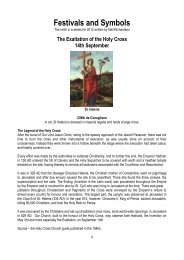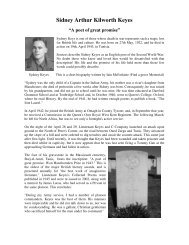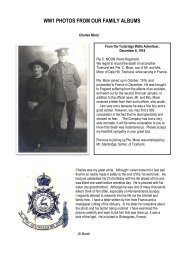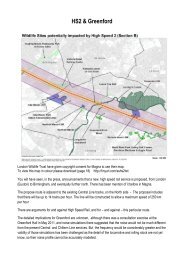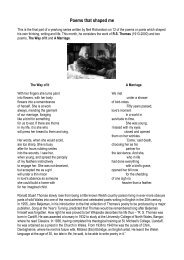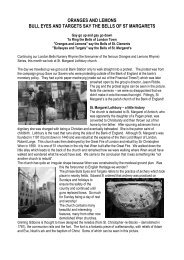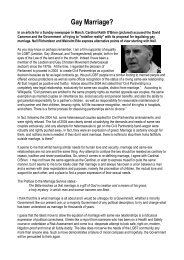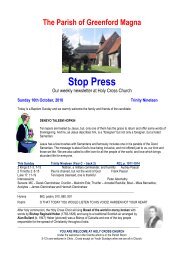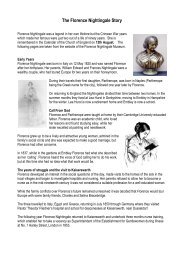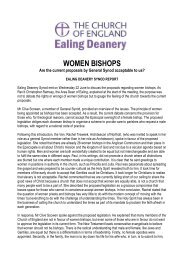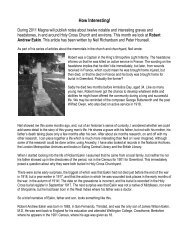oranges and lemons - The Parish of Greenford Magna
oranges and lemons - The Parish of Greenford Magna
oranges and lemons - The Parish of Greenford Magna
You also want an ePaper? Increase the reach of your titles
YUMPU automatically turns print PDFs into web optimized ePapers that Google loves.
It was rebuilt, by Wren <strong>of</strong> course, between 1670 <strong>and</strong> 1683. Wren based his design on the Basilica <strong>of</strong>Maxentius <strong>of</strong> Rome. <strong>The</strong> tower, which houses the Bow Bells, is thought to be his most ambitious project afterSt. Paul’s. It is 68 metres high <strong>and</strong> shows the city symbol <strong>of</strong> a dragon. <strong>The</strong> entrances to the tower are basedon the Hotel De Conti in Paris. <strong>The</strong> peal <strong>of</strong> ten Bow Bells were installed in the 1750s <strong>and</strong> were rung for the firsttime on 4 th June, 1762 to celebrate the King George III’s 25 th birthday.Inside the church is a number <strong>of</strong> interesting features, butfar too many to mention here, so we have picked out afew. This picture (left) is the Rood which hangs abovethe alter <strong>and</strong> was a gift from the Federal Republic <strong>of</strong>Germany in 1964. <strong>The</strong> picture (right) <strong>of</strong> St. George <strong>and</strong>the Dragon is a bronze piece <strong>of</strong> work given to the churchby Norway to commemorate work carried out by theNorwegian resistance <strong>and</strong> as a recording <strong>of</strong> the BowBells were rung across Europe in 1944 to indicate thecoming liberation. <strong>The</strong>re is a beautiful sculpture <strong>of</strong> Mary(to which the church is dedicated too <strong>of</strong> course) with thebaby Jesus. (shown left). Many other features includebeautiful stained glass windows, a stone font as well assome quite modern pieces, such as this Christ figure(shown right)<strong>The</strong> church has many links with famous people such as:John Donne – in 1631 he left a bequest for the upkeep<strong>of</strong> Bow Bell. He wrote the poem “For whom the belltolls” – presumably that bell?Dick Wittington - as well as the Orange <strong>and</strong> Lemon rhyme, the church isassociated with the Dick Wittington rhyme, which tells <strong>of</strong> Dick as a poor orphan attracted to the so called goldpaved streets <strong>of</strong> London. Once here he worked in a rich merchant’s house, but was <strong>of</strong>ten beaten by the cook.Dispirited, one day he decided to leave but heard the Bells <strong>of</strong> Bow ringing out“Turn again, Whittington, Lord Mayor <strong>of</strong> London”And he returned back to his job, eventually marrying his master’s daughter, Alice, <strong>and</strong> becoming Lord Mayor <strong>of</strong>London 3 times.Enoch Powell <strong>and</strong> Malcolm Muggeridge – in 1970 they debated “race” whilst plain clothes detectives <strong>and</strong>television cameras watched on. This was part <strong>of</strong> a series <strong>of</strong> debates <strong>of</strong> the day introduced by JosephMcCulloch, the rector at this time. <strong>The</strong>se ran from 1964-1979 <strong>and</strong> where popular amongst the city workers.McCulloch’s aim was not to recruit Anglicans, nor provide answers but to stimulate thinking. <strong>The</strong> church was<strong>of</strong>ten packed during these debates <strong>and</strong> in 1974 McCulloch produced a book <strong>of</strong> 20 <strong>of</strong> the best. <strong>The</strong> book wasentitled Under Bow Bells <strong>and</strong> his slogan was “I do not know says the great bell <strong>of</strong> bow: certainties divide us<strong>and</strong> doubts bring us together”.<strong>The</strong> church, is <strong>of</strong> course, known as the Cockney’s church as it is said that to be a cockney you must be bornwithin the sounds <strong>of</strong> Bow Bells. As the bells were destroyed in WWII on 11 th May, 1941 <strong>and</strong> not replaced until21 st December, 1961, it can be argued that no Cockneys were born during this period. <strong>The</strong> sound <strong>of</strong> the BowBells were actually used by the BBC at the start <strong>of</strong> all their broadcasts to occupied Europe.



